2 easy ways to keep petunias until spring at home
Petunia is a perennial plant. It is popular among gardeners for its beautiful and long-lasting flowering, hardiness and ease of care. Due to the climatic conditions in our country, it is often grown as an annual.
However, experienced gardeners know that if you take care of the plant in the garden on time, it will survive the winter in the apartment and become a quality planting material for the next year. How to keep petunia at home until spring, read the article.
The content of the article
Conditions for successful wintering of petunias
Petunia is an unpretentious plant that takes root quickly and does not require much attention. from the gardener. It does not have to be grown every year from new planting material. The plant will easily overwinter at home until next season and will become a mother plant for planting material.
To keep petunia in the apartment in winter, it is important to provide her with suitable conditions:
- Temperature... The room should not be too hot or cold. The plant feels comfortable at temperatures from 0 to + 15 ° C. Optimum performance is + 10… + 15 ° C.
- Air humidity... If the indoor air is too dry, the leaves of the plant will begin to turn yellow and dry. The hot air of heating devices is especially dangerous, which leads to the death of the mother liquor. The optimum moisture content for petunias is 75-80%.
- Lighting... During wintering, the plant does not require the use of additional lighting devices. It is enough to put the pot near the window.
- Watering... In winter, a minimum amount of watering is required, but the soil should not dry out and crack. On average, the procedure is carried out 2-3 times a month with water at room temperature. A couple of days after watering, the soil is loosened. Water is poured only at the root.
- Top dressing... During wintering, plant feeding is not required.
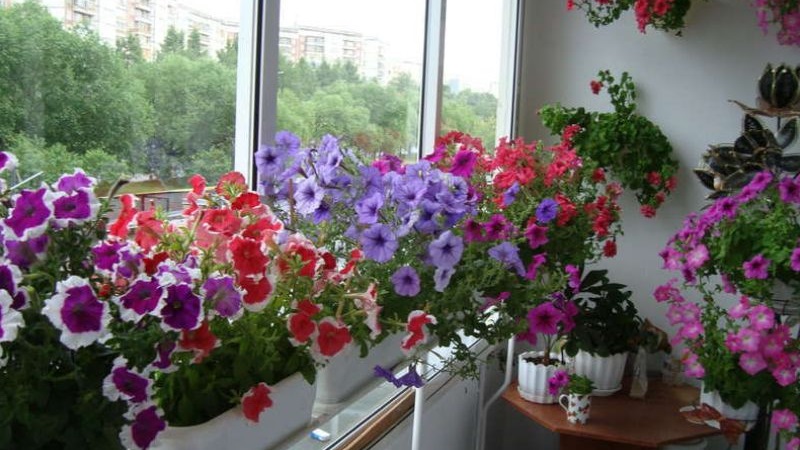
Petunia can spend the winter in an apartment as indoor plant... In this case, until spring, it grows strongly, blooms less abundantly. With this method of growing, there are high risks of damage to the plant by diseases and pests.
It is interesting! Terry petunia reproduces exclusively in a vegetative way. It does not form seeds due to the fact that they are transformed into petals.
Preservation methods
There are two ways to save petunias for the winter.... One of them involves transplanting a plant directly from a flower bed into a pot, and the other involves use of cuttingscollected at the end of flowering. Each of the options has its own advantages and disadvantages.
Cuttings
Saving petunia cuttings for next year allows you to get a hardy, abundantly flowering plant by the spring... In this case, in the fall, before the start of frost, cuttings are cut from the plant in the garden, which are immediately rooted in the ground or water. In winter, they do not need feeding or frequent watering. By spring, the grower is getting well-formed, abundantly flowering plants that are ready to be planted outdoors.
Benefits of wintering petunias as cuttings:
- No need to buy or grow seedlings from seeds. These breeding methods are laborious and costly.
- Obtaining abundant flowering plants. Young petunias grown from cuttings produce much more flowers than biennial plants.
- Simple storage.Petunia cuttings are less likely to get sick and have greater endurance than flowers dug from a flower bed and transplanted into a pot.
- Compactness. Cuttings in small cups take up less space than shrubs in large flower pots.
- Early flowering. If you cut and root the planting material in the fall, then in the spring you will get a large number of flowering plants.
Mature plants
Many gardeners prefer to harvest not cuttings from autumn, but a mother plant... In this case, the petunia bush is dug up and transplanted into a pot. The culture tolerates this procedure well and continues to bloom.
This is the easiest way to help keep petunias until next spring. is he has a number of advantages:
- There is no need to grow seedlings from seed or buy ready-made seedlings.
- Long bloom. The petunia dug from the flower bed continues to bloom even at home until the beginning of winter.
- A large flowering petunia bush can be planted on a flower bed in spring. By this time, the plant will grow even more than last year.
- Variation in the use of the mother plant. The dug out petunia is planted with a whole bush or cut for breeding.
In this form, the flower bush is more often sick and does not always live up to spring, especially if the conditions of its containment are violated.

Where to store
It is important to find a suitable place for growing petunias. It is not recommended to keep it in a room with heating devices in winter... Dry hot air badly affects the plant. Moisturizers will be needed, otherwise the flower will not get winter rest, and its flowering will be less abundant.
In a warm room, petunia is more difficult to keep. To prevent the plant from dying, it will have to be watered and fed more often. During the winter, it grows strongly, so formation will be required.
The following premises are suitable:
- insulated and glazed balcony or loggia;
- window sill in the entrance or non-residential premises.
You can leave the plant in the basement, underground or cellar... In this case, additional lighting will be required.
Interesting on the site:
How to grow petunia from seeds: sowing, leaving, transplanting
What is the danger of aphids on petunias and how to effectively deal with it
How to prepare petunia for wintering
To prevent the flower from dying at home until spring, it is important to know what to do with petunia in the fall. The methods of harvesting planting material differ when using different methods..
In the first way
Cuttings of petunias are carried out in the fall. At this time, it is ready to breed and takes root most easily. The procedure is carried out a week before the onset of the first frost.:
- They choose a petunia bush that was not sick, bloomed profusely and gained a lot of green mass during the season. There are no spots, cracks or other damage on its leaves and shoots. The foliage has a bright green tint and good turgor.
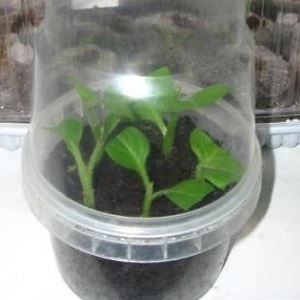 Choose strong, healthy top shoots. Flowers are cut from them.
Choose strong, healthy top shoots. Flowers are cut from them.- From the top of the selected shoots 12-15 cm retreat down and cut at an angle. There should be 4 to 6 leaves on the segments.
- The lower leaves are cut off from the cuttings, leaving only 2 upper ones.
- The cuttings are immersed in a light pink solution of potassium permanganate for 30 minutes. Then it is dipped into a dry root stimulator ("Kornevin").
- A layer of drainage and disinfected soil is poured into individual pots. It is prepared from garden soil, peat and humus. The soil is moistened with warm water.
- Cuttings are planted in individual pots. The depth should be such that the plant stands unsupported.
- Cover the pots with a cut plastic bottle or plastic wrap.
When the plants take root, they are transferred to a cool place, and the film is removed.
Advice! Some gardeners root the cuttings in water and then transplant them into soil.
Second
The second method is much easier to implement. In this case, you will not have to graft petunia.:
- Choose a healthy plant that bloomed profusely all season and did not hurt. It should be free of sluggish foliage and signs of pest infestation.
- Petunia is dug up with a clod of earth, trying not to damage the roots.
- The flower pot is chosen in proportion to its root system. It must have a volume of at least 3 liters.
- Petunia is placed in a pot. The missing volume is filled with soil.
- The plant is watered with a solution of "Fitosporin" or a light pink solution of potassium permanganate.
Petunia continues to bloom after transplant... When the flowers wither and the plant takes root, cut off all the dried and withered leaves and shoots. The bush is cut to a height of 10 cm.
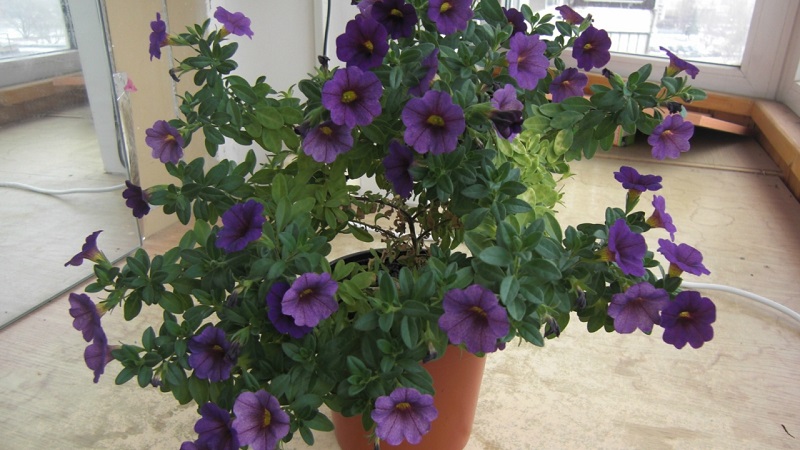
Features of storage of vegetative petunia
Terry petunia also save for the winter in the form of cuttings or an adult bush... However, this plant is more demanding for temperature conditions. It will die if the indicators in the room where it stands fall below + 5 ° C.
Terry varieties are transplanted into larger pots (at least 4-5 liters). Some of the flowers are removed and the soil is moistened with a growth stimulator solution to make it easier for the plant to take root. Dig up vegetative petunia before the start of tangible cold snaps.
Cuttings are cut so that their size reaches 50% of the length of the shoot growing on the bush. In terry varieties, they rooted poorly in water, rot, so they are immediately planted in a pot with earth.
Ampel varieties also more demanding... It is possible to store them in the form of an adult plant planted in a pot, but in this case they often dry out and get sick.
It is recommended to store the ampel petunia in the form of planted cuttings in winter. They are cut at the end of summer so that they have time to take root and adapt to new conditions before winter.
Until February, ampelous varieties often grow. In this case, they are re-cut.
Preparing for spring planting
In order for the flowers that have been kept at home all winter to be ready before spring planting, it is important to change the care for them in time. This is done in mid-February or early March.:
- If the petunia was in an insufficiently bright place, then it is rearranged to the southern windowsill or additional lighting devices are used.
- The number of waterings is increased to 1-2 per week. After each moistening, the soil is loosened. Water at room temperature is poured only under the root so that it does not fall on the leaves.
- Begin to make top dressing. Use preparations for flowering plants, a mixture of potassium sulfate, ammonium nitrate and superphosphate, or a solution of chicken manure.
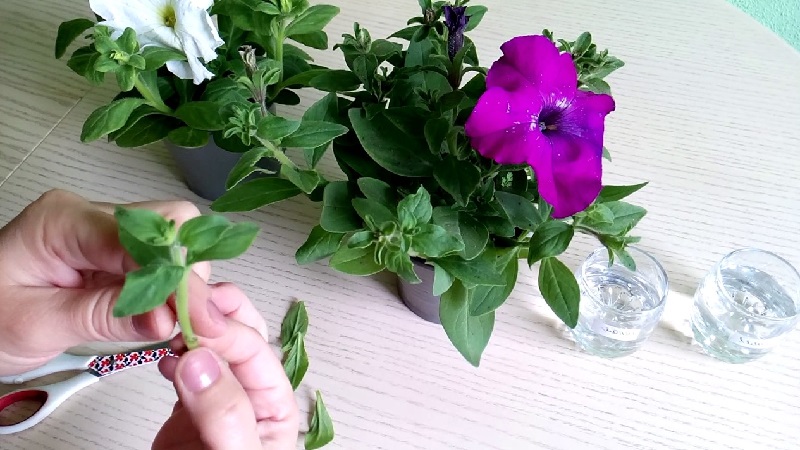
Saplings, which were cuttings in the fall, are planted in open ground directly from the pot... In this case, the size and depth of the hole should be equal to its volume.
In the case of a bush transplanted from a flower bed to a pot, two techniques are used. The first option is to transplant last year's flowering bush from a pot into open ground. Such plants usually bloom less abundantly: the more years the petunia is, the fewer inflorescences it forms.
The second option is to cut the mother plant... This is done in the second half of February. The uppermost, strong and bright shoots are cut from the bush so that at least 3-4 internodes remain on each of them.
The cuttings are dipped in a growth stimulator and planted in loose nutrient soil. A bag is put on top. The plant is ventilated and watered. When it takes root, the greenhouse is dismantled. Before planting in a permanent place, petunia is watered and fed.
Tips from experienced florists
Experienced gardeners know a few secrets of petunia winter storage:
- The plant is pinched at the stage of growing seedlings, it does not matter from seeds or cuttings. This is done after 3-5 leaves are formed. This procedure stimulates the formation of lateral shoots and ensures abundant flowering.
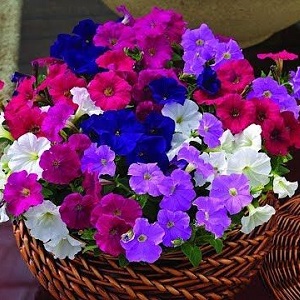 When rooting in spring, it is convenient to use a mixture of vermiculite and garden soil instead of ordinary soil.
When rooting in spring, it is convenient to use a mixture of vermiculite and garden soil instead of ordinary soil.- To reduce the risk of liquid stagnation and root rot, bottom watering is used. Water is not poured into the soil, but into the sump.
- It is convenient to put flowers in a greenhouse with other plants for the winter. In this case, it is important to make sure that there are no signs of pests and diseases on the leaves and shoots.
- Before planting in open ground, the plant is tempered.To do this, they take it out into the street or open the balcony for half an hour, gradually increasing the hardening time to a day.
Conclusion
Petunia is one of the most unpretentious perennial plants. She easily tolerates transplants, and her cuttings take root quickly. This makes it possible to preserve any of its varieties at home in the winter until spring.
During wintering, it is extremely important to ensure optimal conditions for keeping. These include high humidity, moderate temperatures and sunlight. Plant care is minimal. All that is required from the gardener is to water the flower 2-3 times a month and loosen the soil.